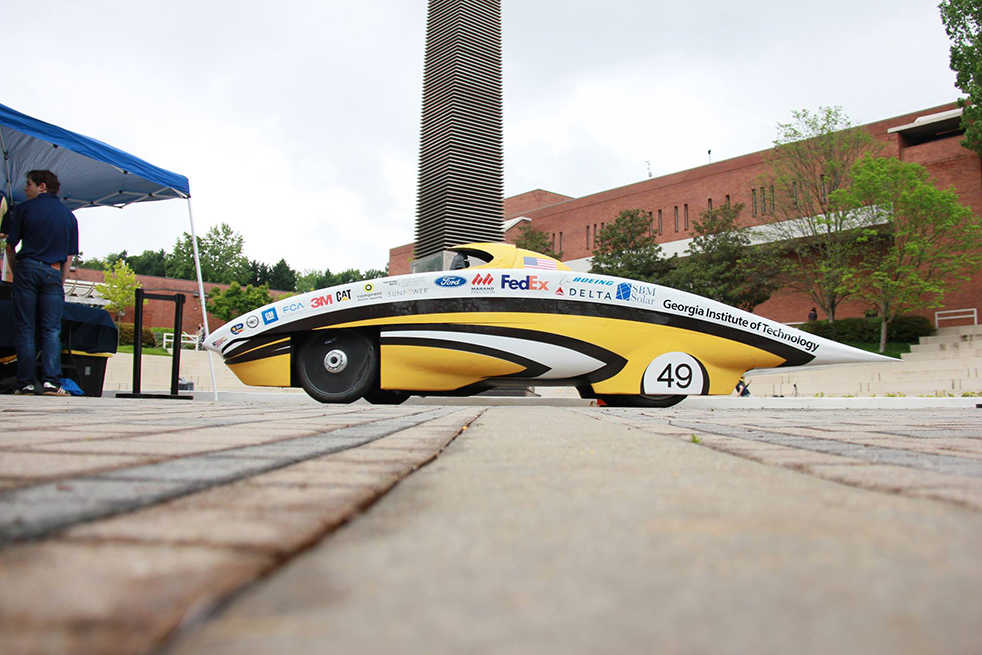Hope for blue skies and sunny weather: the 2018 American Solar Challenge is underway, and the Georgia Tech Solar Racing (GTSR) team hopes to put forth their best effort.
The American Solar Challenge occurs every two years, and this year follows a path over 1700 miles long from Omaha, Nebraska, to Bend, Oregon, following stretches of the Oregon Trail through four different states.
Lasting from July 13 to 22, the trek is split into five stages, each hundreds of miles long — yet in the first two stages of the 2018 competition, GTSR’s car has only been able to complete 63.8 miles, due to debilitating electrical problems that surprised the team, who had cruised through the Formula Sun Grand Prix (FSGP) qualifiers.
“Due to some never-before-seen electrical issues that did not occur during our 314 miles of driving at FSGP, we have trailered to the next location on the ASC route to continue the journey,” the GTSR reported on Facebook on July 14, the day after the first leg began. “We will be working on debugging these problems today and hope to make more progress tomorrow.”
Here, to “trailer” means exactly what it sounds like: loading the car up, driving it to the checkpoint and racing against the clock to figure out what went wrong.
Although the team has had a rocky start, their challenges represent the complexity of the mission to drive a solar car across the country.
Developing a competitive solar-powered car requires a confluence of hard work and talents across mechanical, electrical, and operational engineering. After learning lessons from the design of their first self-built model, the 2015 SJ-1 Endeavor, the team has strived to produce a sleeker, faster design.
Their work has culminated in SR-2 Odyssey, which at a top speed of 80 mph and a weight of 250 kilograms, is both 35 mph faster and nearly 70 kilograms lighter than its predecessor.
“SR-2 Odyssey is GTSR’s first completely new car in almost 6 years, and represents all of our lessons learned, design experience, and nearly 20,000 hours of student’s work,” the GTSR writes on its GoFundMe page, where it is raising funds to help support the summer journey. “She takes advantage of the latest and greatest improvements in the green energy field to achieve unprecedented performance for our program.”
The car, and its solo driver, are not the only factors in the equation of a successful team — the cross-country journey of the Odyssey bears more semblance to a Homer epic, with a fleet of support students and vehicles addressing challenges along the way.
“Moving 18 students, a solar car, 3 support vehicles and a mobile shop on a 5,300-mile round trip journey is an exhilarating prospect,” the team wrote on their Facebook page in June.
Each of those components also costs money, which quickly runs thin despite the multiple sponsorships from industry whose logos line the curves of the Odyssey — hence the GoFundMe campaign. The ongoing campaign covers operational costs during competition and has already raised $2,755 of its $5,000 goal.
“All funds raised will go towards food, fees, spare parts, and fuel for our trip this summer. (Yes, unfortunately our support vehicles do still run on gasoline),” the team writes online.
“We will make sure to specifically focus on the lessons learned, as we most certainly have learned a lot of lessons these past few weeks,” the team adds. “We hope to come back far more successful the next year.”
But, for now, the GTSR team has its eyes ahead on the race: the miles, the road and the wreck that keeps on rambling.
